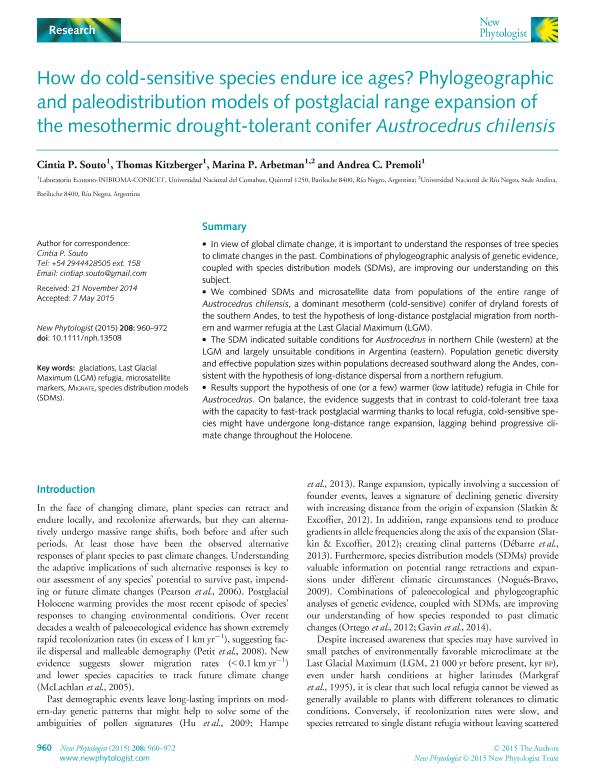Artículo
How do cold-sensitive species endure ice ages? Phylogeographic and paleodistribution models of postglacial range expansion of the mesothermic drought-tolerant conifer Austrocedrus chilensis
Fecha de publicación:
06/2015
Editorial:
Wiley Blackwell Publishing, Inc
Revista:
New Phytologist
e-ISSN:
1469-8137
Idioma:
Inglés
Tipo de recurso:
Artículo publicado
Clasificación temática:
Resumen
In view of global climate change, it is important to understand the responses of tree species to climate changes in the past. Combinations of phylogeographic analysis of genetic evidence, coupled with species distribution models (SDMs), are improving our understanding on this subject.
We combined SDMs and microsatellite data from populations of the entire range of Austrocedrus chilensis, a dominant mesotherm (cold-sensitive) conifer of dryland forests of the southern Andes, to test the hypothesis of long-distance postglacial migration from northern and warmer refugia at the Last Glacial Maximum (LGM).
The SDM indicated suitable conditions for Austrocedrus in northern Chile (western) at the LGM and largely unsuitable conditions in Argentina (eastern). Population genetic diversity and effective population sizes within populations decreased southward along the Andes, consistent with the hypothesis of long-distance dispersal from a northern refugium.
Results support the hypothesis of one (or a few) warmer (low latitude) refugia in Chile for Austrocedrus. On balance, the evidence suggests that in contrast to cold-tolerant tree taxa with the capacity to fast-track postglacial warming thanks to local refugia, cold-sensitive species might have undergone long-distance range expansion, lagging behind progressive climate change throughout the Holocene.
Archivos asociados
Licencia
Identificadores
Colecciones
Articulos(INIBIOMA)
Articulos de INST. DE INVEST.EN BIODIVERSIDAD Y MEDIOAMBIENTE
Articulos de INST. DE INVEST.EN BIODIVERSIDAD Y MEDIOAMBIENTE
Citación
Souto, Cintia Paola; Kitzberger, Thomas; Arbetman, Marina P.; Premoli Il'grande, Andrea Cecilia; How do cold-sensitive species endure ice ages? Phylogeographic and paleodistribution models of postglacial range expansion of the mesothermic drought-tolerant conifer Austrocedrus chilensis; Wiley Blackwell Publishing, Inc; New Phytologist; 208; 3; 6-2015; 960-972
Compartir
Altmétricas




